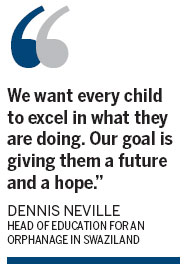AIDS orphanage revives ghost town
|
|
Lost in the mountains of Swaziland, Bulembu became a ghost town when the local asbestos mine closed, cutting off its lifeblood.
But now the town is coming back, centred on an orphanage taking in children whose parents have often died of AIDS.
"The babies are abandoned, maybe put in a plastic bag on the side of the road, maybe in the pit latrines," said Zanele Maseko, head of the nursery for the smallest orphans.
"What the police told us, they found a baby who was buried alive. She is a big girl now."
Swaziland has the world's highest rate of HIV infection, with at least one in four adults carrying the virus.
A crushing financial crisis has left the tiny monarchy struggling to pay for medicines and for orphans' education.
About 120,000 children have been orphaned in this landlocked nation in southern Africa, comprising more than 10 percent of the total population.
Those startling statistics inspired Canadian entrepreneur Volker Wagner to buy the entire town of Bulembu in 2006, five years after it was abandoned, and entrust it to a Canadian evangelical ministry which actually runs the place.
They have created a private community, a sort of "Christian kolkhoz", which is developing around the orphanage that now houses 303 children, ranging in ages from two weeks to 21 years.
"At present financial projections, we believe that Bulembu can be sustainable by 2020 with 1,000 children in our care," said Andrew Le Roux, executive director Bulembu Ministries Swaziland, which manages the project for Wagner.
"But this is a minimum, and as we strive to grow the businesses, this number will increase. We believe 2,000 is the maximum number of children that the infrastructure can sustain."
The idea is to make Bulembu completely self-sufficient. Its leaders, mainly white South Africans, aim to train Swazis to take over the project.
Bulembu currently sells wood, milk, bread, honey, mineral water and souvenirs to outsiders. Those businesses employ several hundred people and the revenues fund 45 percent of the town's operations.
The rest comes from private donations, mainly collected in Canada, which also fund new investments.
A museum is in the works, along with a guesthouse for visitors and benefactors who come from around the world to volunteer. The old mining staff quarters have been fixed up to house the children, their caregivers and the employees.
Many old buildings have been gutted and will need major work, but there's still plenty of room for expansion.
Bulembu houses about 1,400 people, compared to 10,000 when its asbestos mine was in full swing.
The mine's hospital has been turned into a high school, after there were too many students for the original school.
A training center has opened to prepare the youth for jobs in tourism, and the Swazi government has proposed building a small technical college.
The schools revolve around a merit system, from nursery school up. The orphans have no money, but can "buy" little things with merits they earn for good grades or keeping a tidy desk.
"We want every child to excel in what they are doing," said Dennis Neville, head of education.
"Our goal is giving them a future and a hope," he said. "What we're trying to do is prepare these children to become good Swazi citizens, to become children who can step into leadership roles. We want the children to be Swazi leaders."
Agence France-Presse



















